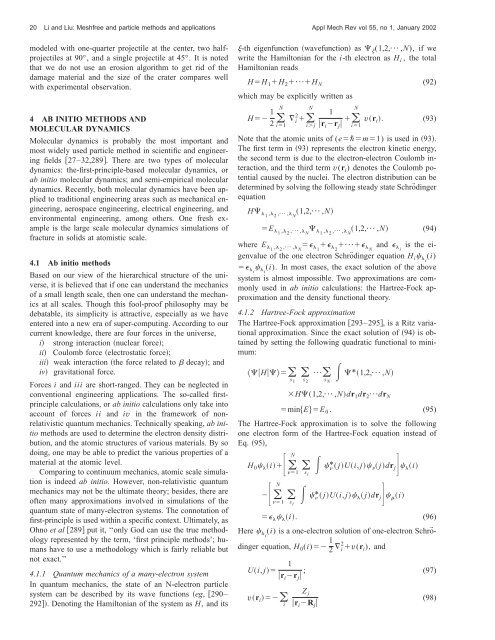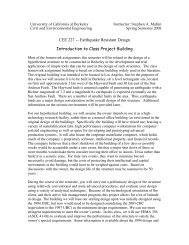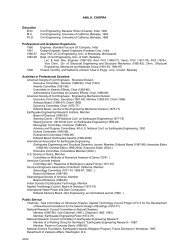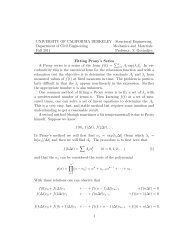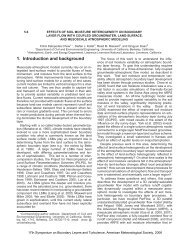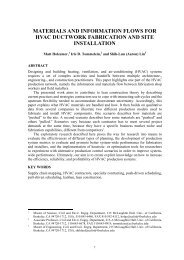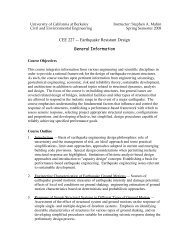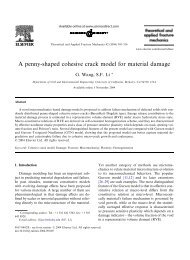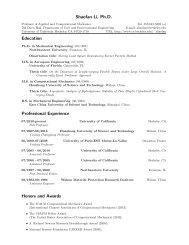Meshfree and particle methods and their applications - TAM ...
Meshfree and particle methods and their applications - TAM ...
Meshfree and particle methods and their applications - TAM ...
You also want an ePaper? Increase the reach of your titles
YUMPU automatically turns print PDFs into web optimized ePapers that Google loves.
20 Li <strong>and</strong> Liu: <strong>Meshfree</strong> <strong>and</strong> <strong>particle</strong> <strong>methods</strong> <strong>and</strong> <strong>applications</strong> Appl Mech Rev vol 55, no 1, January 2002<br />
modeled with one-quarter projectile at the center, two halfprojectiles<br />
at 90°, <strong>and</strong> a single projectile at 45°. It is noted<br />
that we do not use an erosion algorithm to get rid of the<br />
damage material <strong>and</strong> the size of the crater compares well<br />
with experimental observation.<br />
4 AB INITIO METHODS AND<br />
MOLECULAR DYNAMICS<br />
Molecular dynamics is probably the most important <strong>and</strong><br />
most widely used <strong>particle</strong> method in scientific <strong>and</strong> engineering<br />
fields 27–32,289. There are two types of molecular<br />
dynamics: the-first-principle-based molecular dynamics, or<br />
ab initio molecular dynamics; <strong>and</strong> semi-empirical molecular<br />
dynamics. Recently, both molecular dynamics have been applied<br />
to traditional engineering areas such as mechanical engineering,<br />
aerospace engineering, electrical engineering, <strong>and</strong><br />
environmental engineering, among others. One fresh example<br />
is the large scale molecular dynamics simulations of<br />
fracture in solids at atomistic scale.<br />
4.1 Ab initio <strong>methods</strong><br />
Based on our view of the hierarchical structure of the universe,<br />
it is believed that if one can underst<strong>and</strong> the mechanics<br />
of a small length scale, then one can underst<strong>and</strong> the mechanics<br />
at all scales. Though this fool-proof philosophy may be<br />
debatable, its simplicity is attractive, especially as we have<br />
entered into a new era of super-computing. According to our<br />
current knowledge, there are four forces in the universe,<br />
i strong interaction nuclear force;<br />
ii Coulomb force electrostatic force;<br />
iii weak interaction the force related to decay; <strong>and</strong><br />
iv gravitational force.<br />
Forces i <strong>and</strong> iii are short-ranged. They can be neglected in<br />
conventional engineering <strong>applications</strong>. The so-called firstprinciple<br />
calculations, or ab initio calculations only take into<br />
account of forces ii <strong>and</strong> iv in the framework of nonrelativistic<br />
quantum mechanics. Technically speaking, ab initio<br />
<strong>methods</strong> are used to determine the electron density distribution,<br />
<strong>and</strong> the atomic structures of various materials. By so<br />
doing, one may be able to predict the various properties of a<br />
material at the atomic level.<br />
Comparing to continuum mechanics, atomic scale simulation<br />
is indeed ab initio. However, non-relativistic quantum<br />
mechanics may not be the ultimate theory; besides, there are<br />
often many approximations involved in simulations of the<br />
quantum state of many-electron systems. The connotation of<br />
first-principle is used within a specific context. Ultimately, as<br />
Ohno et al 289 put it, ‘‘only God can use the true methodology<br />
represented by the term, ‘first principle <strong>methods</strong>’; humans<br />
have to use a methodology which is fairly reliable but<br />
not exact.’’<br />
4.1.1 Quantum mechanics of a many-electron system<br />
In quantum mechanics, the state of an N-electron <strong>particle</strong><br />
system can be described by its wave functions eg, 290–<br />
292. Denoting the Hamiltonian of the system as H, <strong>and</strong> its<br />
-th eigenfunction wavefunction as (1,2,¯ ,N), if we<br />
write the Hamiltonian for the i-th electron as H i , the total<br />
Hamiltonian reads<br />
HH 1 H 2 ¯H N (92)<br />
which may be explicitly written as<br />
H 1 N N<br />
N<br />
2 1<br />
2 i <br />
i1 i j r i r j i1<br />
vr i . (93)<br />
Note that the atomic units of (em1) is used in 93.<br />
The first term in 93 represents the electron kinetic energy,<br />
the second term is due to the electron-electron Coulomb interaction,<br />
<strong>and</strong> the third term v(r i ) denotes the Coulomb potential<br />
caused by the nuclei. The electron distribution can be<br />
determined by solving the following steady state Schrödinger<br />
equation<br />
H 1 , 2 ,¯ , N<br />
1,2,¯ ,N<br />
E 1 , 2 ,¯ , N<br />
1 , 2 ,¯ , N<br />
1,2,¯ ,N (94)<br />
where E 1 , 2 ,¯ , N<br />
1 2 ¯ N <strong>and</strong> i is the eigenvalue<br />
of the one electron Schrödinger equation H i i (i)<br />
i i (i). In most cases, the exact solution of the above<br />
system is almost impossible. Two approximations are commonly<br />
used in ab initio calculations: the Hartree-Fock approximation<br />
<strong>and</strong> the density functional theory.<br />
4.1.2 Hartree-Fock approximation<br />
The Hartree-Fock approximation 293–295, is a Ritz variational<br />
approximation. Since the exact solution of 94 is obtained<br />
by setting the following quadratic functional to minimum:<br />
*1,2,¯ ,N<br />
H<br />
s1<br />
<br />
s2<br />
¯<br />
sN<br />
<br />
H1,2,¯ ,Ndr 1 dr 2¯dr N<br />
minEE 0 . (95)<br />
The Hartree-Fock approximation is to solve the following<br />
one electron form of the Hartree-Fock equation instead of<br />
Eq. 95,<br />
N<br />
H 0 i si * jUi, j jdr j i<br />
<br />
1<br />
N<br />
<br />
1<br />
si <br />
<br />
* jUi, j jdr j i<br />
i. (96)<br />
Here i (i) is a one-electron solution of one-electron Schrödinger<br />
equation, H 0 (i) 1 2 i 2 v(r i ), <strong>and</strong><br />
Ui, j 1<br />
r i r j ; (97)<br />
vr i <br />
i<br />
Z j<br />
r i R j <br />
(98)


